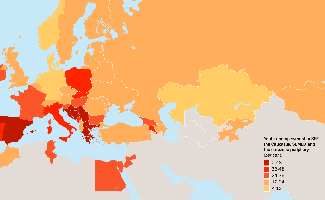Macroeconomic overview
Macroeconomic developments and outlook
Growth in the transition region slowed significantly in 2012 and has failed to recover in 2013. While the effects of the eurozone crisis on trade and capital flows have gradually abated, there has been a downturn in key emerging markets and in...
Slow-down in domestic demand
Most transition economies – 27 out of 34 – saw lower growth in 2012 than in 2011 (see Chart M.2). This slow-down encompassed all regions, with the exception of the southern and eastern Mediterranean (SEMED) countries, where a slight increase...
Persistent high unemployment
Continuing high rates of unemployment – in double digits in most CEB and SEE countries – are mostly a legacy of deep recessions in 2008-09. Output remains below pre-crisis levels in six CEB countries (as well as in Ukraine) and the persistence of...
Stable inflation
Consistent with an environment of depressed demand, inflation has continued to fall in most CEB and SEE countries, dipping below two per cent in the first half of 2013. The exception was Serbia, where prices spiked due to a poor harvest,...
Trade reversal
After the eurozone crisis intensified in late 2011 and the first half of 2012 exports from CEB and SEE countries fell significantly. This trend has reversed over the past year, as exports grew in all countries apart from Estonia. This recovery...
Capital flows below pre-crisis levels
Private capital has continued to flow into the transition region, but at modest rates. Emerging markets globally received significant inflows in the second half of 2012 and the first quarter of 2013, as low interest rates in advanced economies...
Slowing remittance growth
Remittances are the single largest source of international payments for several Central Asian, SEE and SEMED countries. However, in 2012 the annual growth rate of remittances declined in all but four countries (see Chart M.9). Egypt, Jordan and...
Cross-border deleveraging constrains credit
Foreign banks have continued to withdraw funding from the transition region, but the pace of deleveraging has moderated. The eurozone crisis triggered a sharp reduction in international bank claims in the second half of 2011. Outflows slowed in...
Macroeconomic policy
Monetary policy has remained accommodative in much of the transition region, reflecting the economic downturn and the relative lack of inflationary pressures. Central banks in the CEB and SEE regions have continued to cut interest rates, which...
Outlook and risks
Growth in the transition region is expected to slow from 2.7 per cent in 2012 to 2 per cent in 2013 as a whole. This reflects the continued deceleration – of the Russian economy in particular – in the first half of the year. However, coinciding...
References
S. Avdjiev, Z. Kuti and E. Takáts (2012)“The euro area crisis and cross-border bank lending to emerging markets”, BIS Quarterly Review, December.
J. Bouhga-Hagbe (2006)“Altruism and workers’ remittances: evidence from selected countries in the...



















